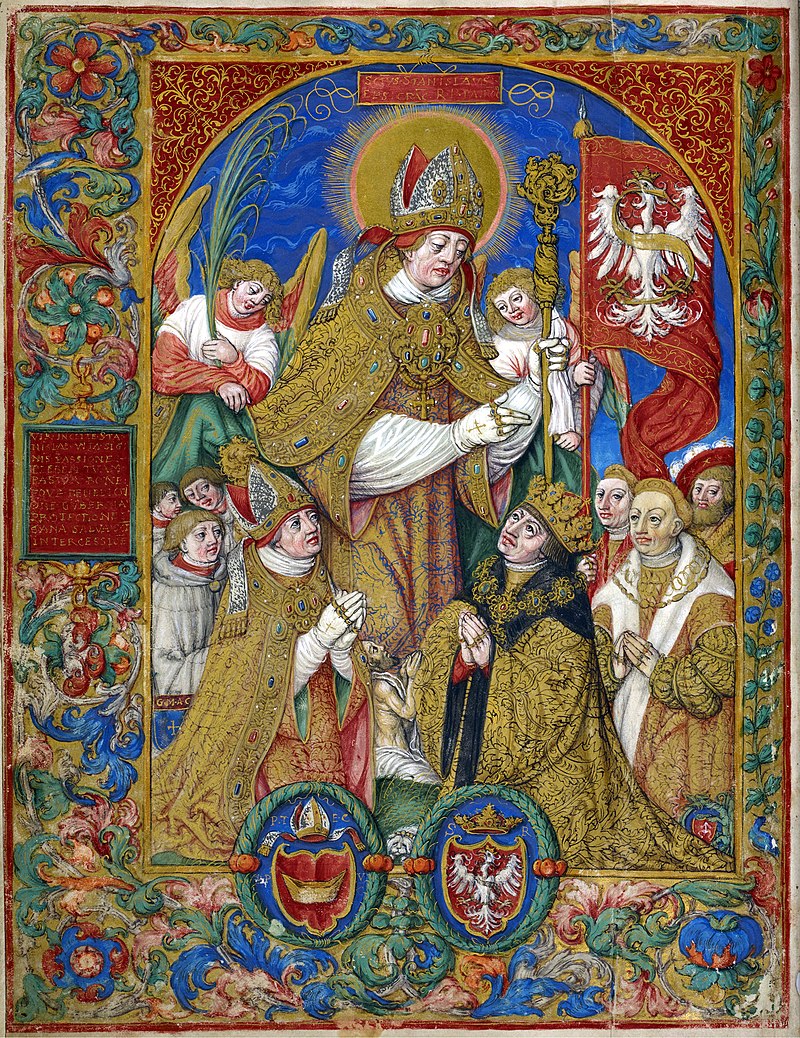Text and Illustrations from The Saint Andrew Daily Missal,
unless otherwise stated.
The Holy Four Crowned Martyrs.
Feast Day 8 November.
Simple.
Red Vestments.
English: The Four Crowned Saints. Statue commissioned
by the Arte dei Maestri di Pietra e Legname
(Guild of Wood and Stone Cutters),
Orsanmichele, Florence, Italy. Sculptor: Nanni di Banco.
Français: Les Quatre saints couronnés. Statue commandée par l'arte dei Maestri di Pietra e Legname (guilde des tailleurs de bois et de pierre). Orsanmichele, Florence.
Italiano: Tabernacolo dell'arte dei Maestri di Pietra e Legname, con Quattro Santi Coronati di Nanni di Banco. Orsanmichele, Firenze.
Date: 1408.
Source: it:Utente:MM, own picture (April 2005).
Author: Nanni di Banco (Italian, 1375–1421).
(Wikimedia Commons)
Mass: Intret.
The Basilica of The Holy Four Crowned Martyrs, Rome.
Available on YouTube at
The designation "Four Crowned Martyrs" or "Four Holy Crowned Ones" (in Latin, Sancti Quatuor Coronati), actually refers to nine separate Martyrs, divided into two groups:
First Group: Severus (or Secundius); Severian(us); Carpophorus (Carpoforus); Victorinus (Victorius, Vittorinus).
Second Group: Claudius; Castorius; Symphorian (Simpronian); Nicostratus; and Simplicius.
According to the Golden Legend, the names of the members of the First Group were not known at the time of their death “but were learned through the Lord’s revelation after many years had passed." They were called the "Four Crowned Martyrs", because their names were unknown ("Crown" referring to The Crown of Martyrdom).
The Martyrdom of The Four Crowned Martyrs.
Painting by Mario Minniti, in San Pietro dal Carmine, Siracusa, Sicily, Italy.
Date: Circa 1620.
Source: http://www.parrocchiadelcarmine.
Author: Minitti, Mario.
(Wikimedia Commons)
Severus (or Secundius), Severian(us), Carpophorus, Victorinus were Martyred at Rome, or Castra Albana, according to Christian Tradition.
According to the Passion of Saint Sebastian, the four Saints were soldiers (specifically "Cornicularii", or Clerks, in charge of all the Regiment's records and paperwork), who refused to sacrifice to Aesculapius, and therefore were killed by order of Emperor Diocletian (284 A.D. - 305 A.D.), two years after the death of the five sculptors. The bodies of the Martyrs were buried in the Cemetery of Santi Marcellino e Pietro, on the fourth mile of via Labicana, by Pope Miltiades and Saint Sebastian (whose skull is preserved in the Church).
The Second Group, according to Christian Tradition, were sculptors from Sirmium, who were killed in Pannonia. They refused to fashion a pagan statue for the Emperor Diocletian or to offer sacrifice to the Roman gods. The Emperor ordered them to be placed alive in lead coffins and thrown into the sea, about 287 A.D. Simplicius was killed with them.
According to the Catholic Encyclopedia, “the Acts of these Martyrs, written by a Revenue Officer, named “Porphyrius”, probably in the 4th-Century A.D., relates to the five sculptors that, although they raised no objections to executing such profane images as Victoria, Cupid, and the Chariot of the Sun, they refused to make a statue of Æsculapius, for a heathen temple. For this they were condemned to death as Christians. They were put into leaden caskets and drowned in The River Save. This happened towards the end of 305 A.D.”
English: Stained-Glass Window of the “Four Crowned Martyrs” in the Assumption Church of Samoëns
(Haute-Savoie, France).
Français: Vitrail (1982) dit des “Quatre Couronnés” dans l’église de l’Assomption à Samoëns (Haute-Savoie).
Les fr:Quatre Saints couronnés sont les patrons
de la confrérie des maçons de Samoëns.
Photo: 29 August 2013.
Source: Own work.
Author: Tangopaso
(Wikimedia Commons)
When the names of the First Group were learned, it was decreed that they should be Commemorated with the Second Group. The bodies of the First Group were interred by Saint Sebastian and Pope Melchiades (Miltiades) at the third milestone on the Via Labicana, in a sandpit where rested the remains of other executed Christians. According to tradition, since the names of the Four Martyred Soldiers could not be authentically established, Pope Melchiades commanded that, since the date of their deaths (8 November) was the same as that of the Second Group, their anniversary should be celebrated on that day.
It is unclear where the names of the Second Group actually come from. The tradition states that Pope Melchiades asked that the Saints be Commemorated as Claudius, Nicostratus, Simpronian, and Castorius. These same names actually are identical to names shared by converts of Polycarp the Priest, in the legend of Saint Sebastian.
Entrance of San Silvestro Chapel, at the Basilica
dei SS. Quattro Coronati, Rome, Italy, with painting
of The Four Crowned Martyrs.
Date: Circa 1570.
Source: www.universitadeimarmorari.it/ universita.html.
Author: Unknown.
(Wikimedia Commons)
According to the Catholic Encyclopedia, “this report has no historic foundation. It is merely a tentative explanation of the name Quatuor Coronati, a name given to a group of really authenticated Martyrs, who were buried and venerated in the Catacomb of Saints Peter and Marcellinus, the real origin of which, however, is not known. They were classed with the Five Martyrs of Pannonia in a purely external relationship.”
The bodies of the Martyrs are kept in four ancient sarcophagi, in the Crypt of Santi Marcellino e Pietro. According to a lapid, dated 1123, the head of one of the four Martyrs is buried in Santa-Maria-in-Cosmedin.
Basilica of Santi Quattro Coronati, Rome.
Photo: 10 November 2005.
Source: Own work.
Author: Lalupa.
(Wikimedia Commons)
In the 4th- and 5th-Centuries A.D., a Basilica (the Basilica of Santi Quattro Coronati) was erected and dedicated in honour of these Martyrs on the Caelian Hill, probably in the general area where Tradition located their execution. This became one of the Titular Churches of Rome and was restored several times.
The Four Crowned Martyrs were Venerated early on in England, with Saint Bede noting that there was a Church Dedicated to them in Canterbury. This Veneration can perhaps be accounted for by the fact that Augustine of Canterbury came from a Monastery near the Basilica of Santi Quattro Coronati, in Rome, or because their Relics were sent from Rome to England in 601 A.D.
Their connection with stone-masonry, in turn, connected them to the Freemasons. One of the scholarly journals of the English Freemasons was called Ars Quatuor Coronatorum, and the Stonemasons of Germany adopted them as Patron Saints of “Operative Masonry.”

























